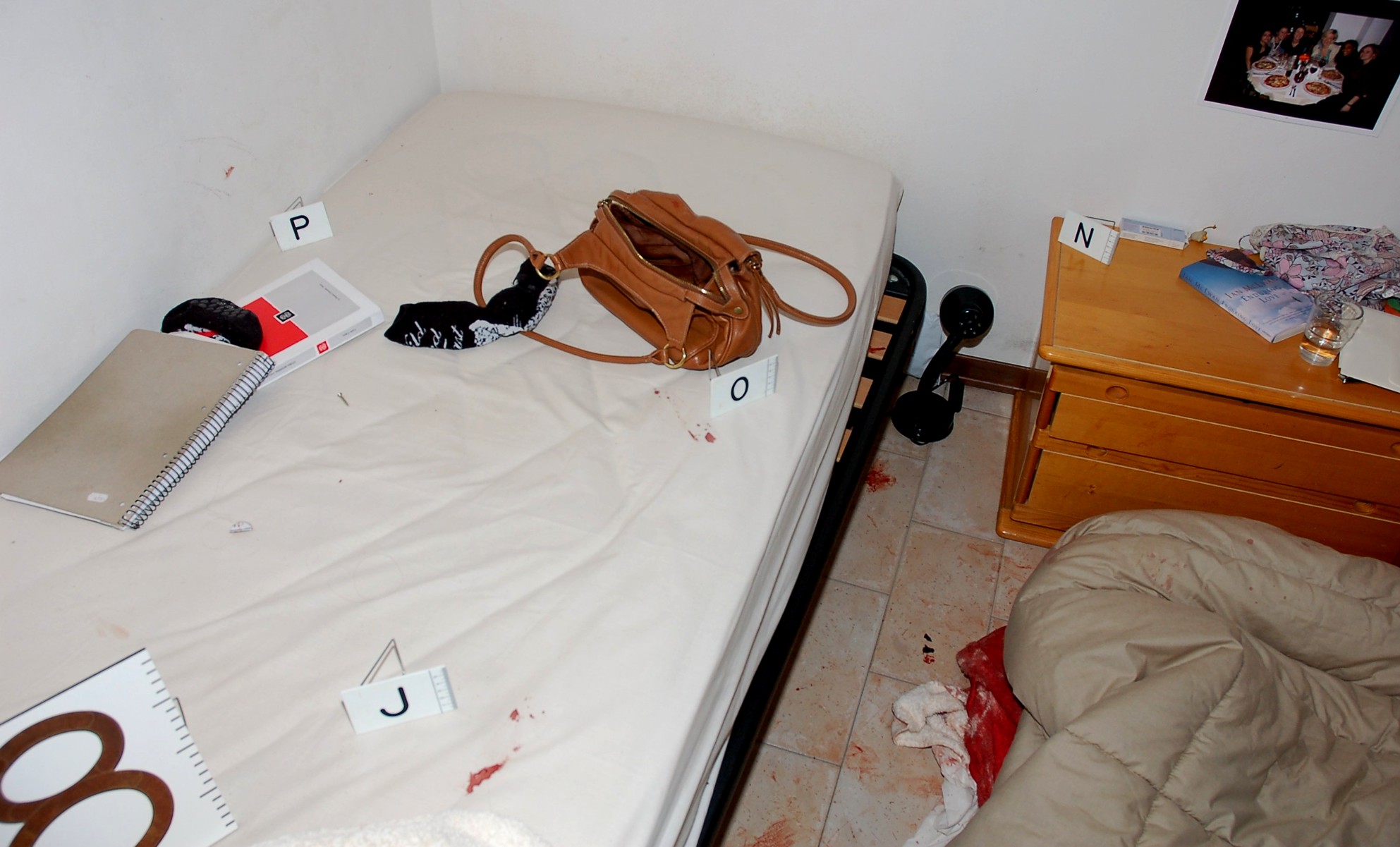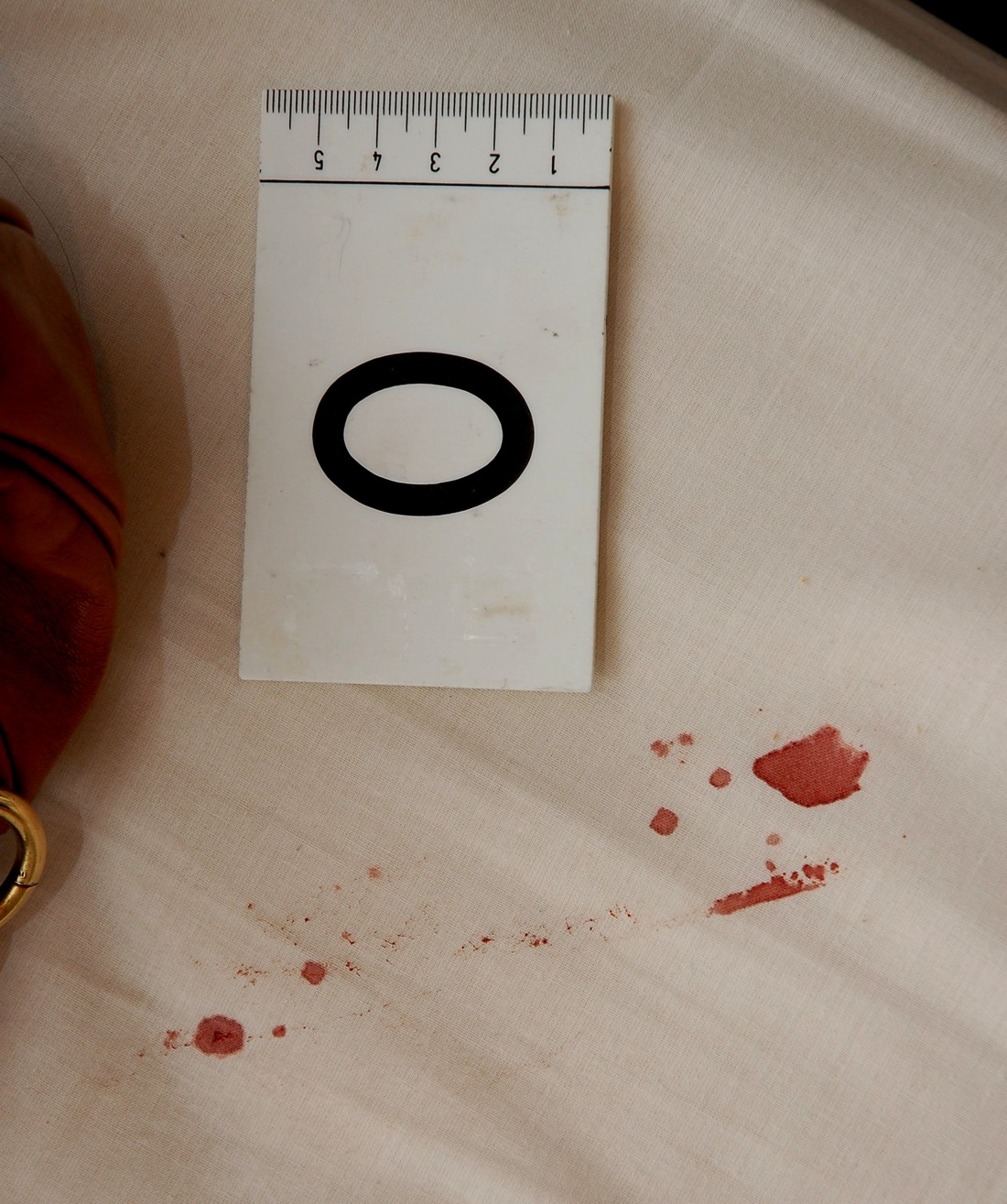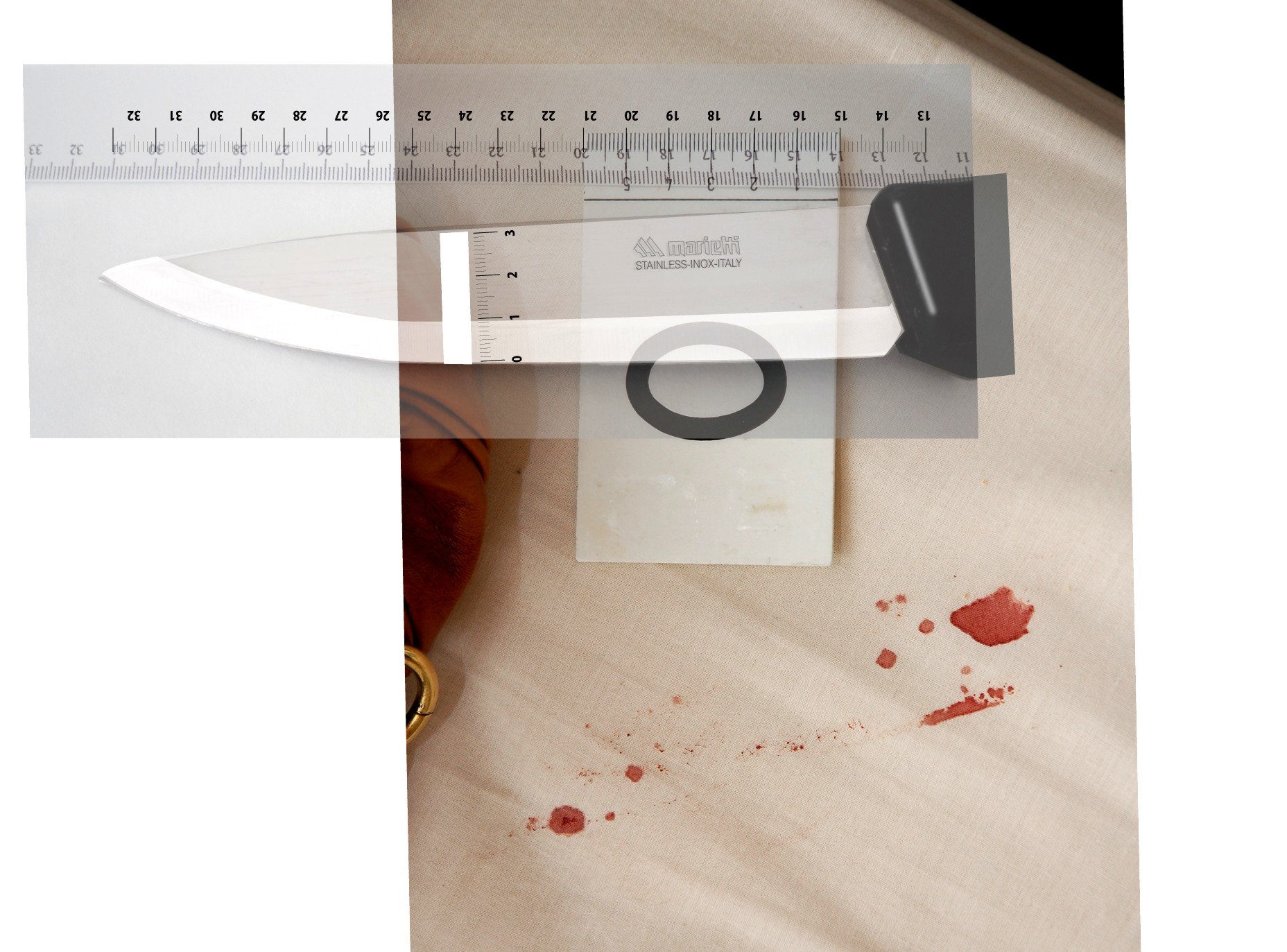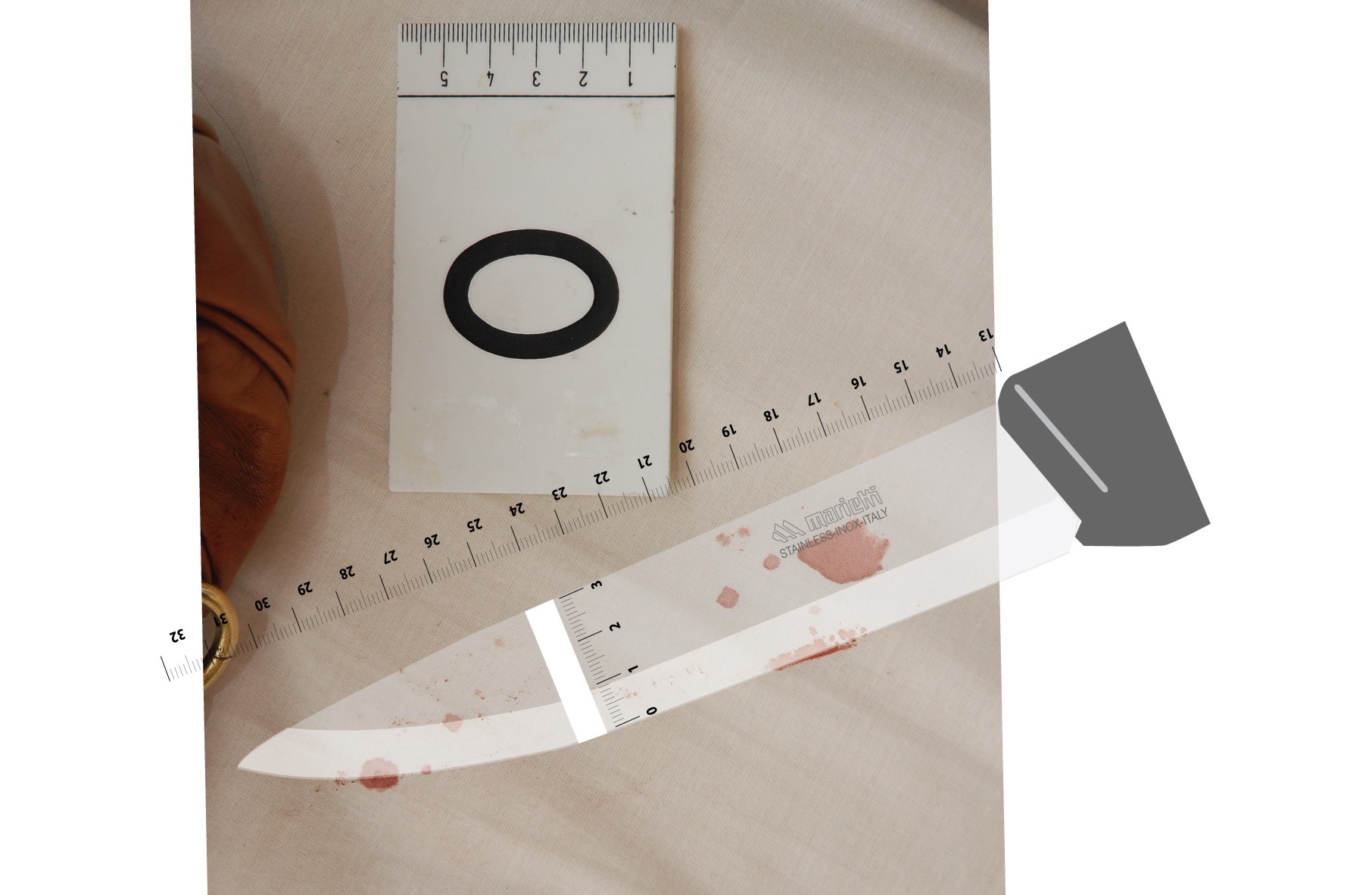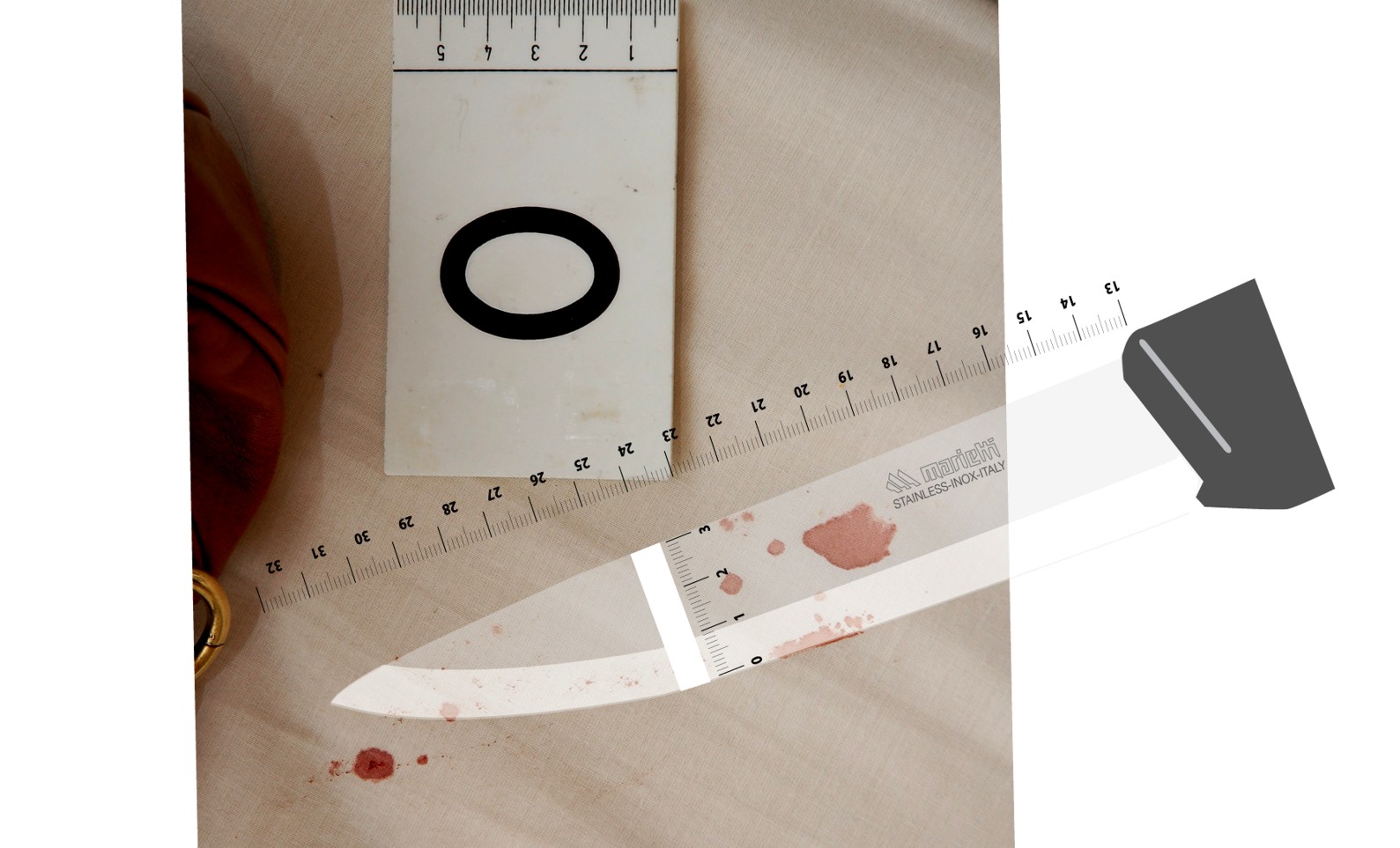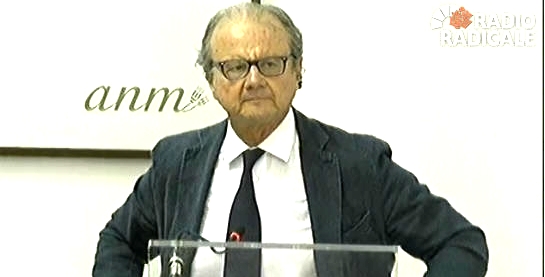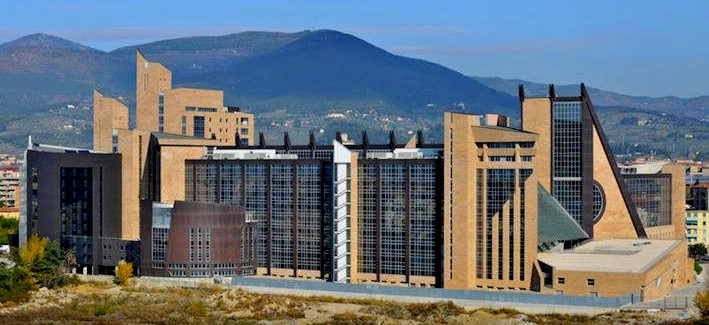
Category: DNA and luminol
Tuesday, January 28, 2014
Strong Proof That Raffaele Sollecito Also Stabbed Meredith Kercher Causing The Lesser Wound.
Posted by Ergon
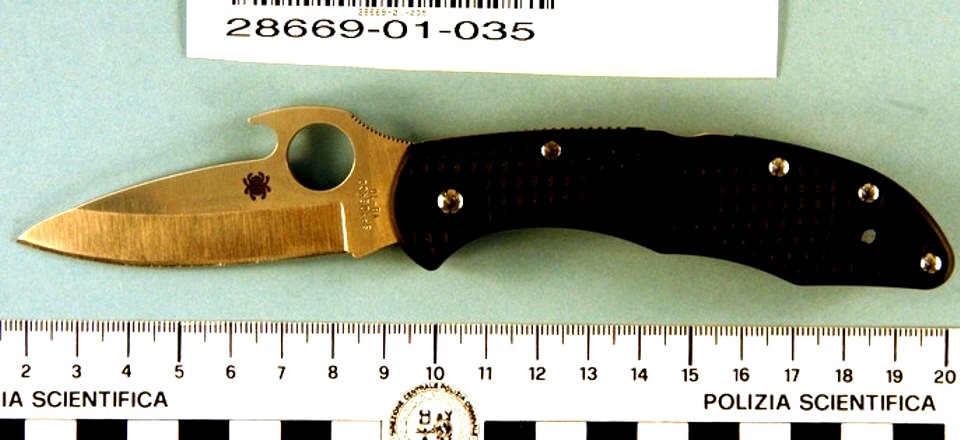
Sollecito’s “pocket knife” is a Spiderco Delica4 Emerson Opener made for killing people
Overview
This picks up from from my previous post just below on the large knife that overwhelming evidence shows was wielded by Amanda Knox.
Sometime around Thursday, January 30, 2014, Judge Nencini of the Florence Appeals Court will be delivering the verdict of the court in the case of Amanda Knox and Raffaele Sollecito, at which time all arguments regarding the knives, staged burglary, DNA and forensics, false accusation, wonky alibis, and reliability of witnesses will be rendered moot.
There will be nothing left but an argument about the legality of the process, and not the evidence, presented by the defenses if they choose to at some point in the fall of 2014 before Cassazione, the Supreme Court in Rome.
But, until then, we are left with the indelible image of Raffaele Sollecito’s defense attorney Giulia Bongiorno a few days ago flailing with two knives in court, arguing (1) the kitchen knife doesn’t fit the major wound, and (2) there’s a missing knife, which she suggested was a pocket knife wielded by Rudy Guede.
In part I, I proved that the imprint of the knife on the mattress sheet matched the kitchen knife, in shape and dimensions. We have already seen in other articles here on TJMK, that there is a definitive match with Knox and Meredith Kercher’s DNA on the murder weapon, and now we know it was transported to the cottage, to leave its mirror image on the bed.
Here, in part II, is a recap of Massei on the knives and wounds inflicted on Meredith Kercher, and how the defense continually tried to divert us away from the knife image by saying it did not fit the dimensions of the major wound.
Also we will have Frank Sfarzo and Bruce Fischer’s amateurish attempts to prove that Rudy Guede caused the knife wounds. And it will try to address what happened to the missing knife that inflicted the lesser wound on Meredith, and who might have wielded it.

Closeup of the stabbing end of the Spiderco knife shown at the top
Deliberate false claims
One of the many myths surrounding this case was that investigators had no reason to seize the kitchen knife from Sollecito’s flat, and when I showed the photos from Conti’s lab, with the deep scratches on it, that it may have been altered in some way, and denying that was where some of Meredith’s DNA might have been trapped. IIP even posted an out of focus picture some time back to prove that point.
Here is Frank Sforza on the late and unlamented Perugia Shock.‘ANY KNIFE COULD HAVE DONE THAT WOUND’
End of a Myth
Frank Sfarzo, Sept. 19, 2009
Quote: “It was introduced in the room, it was taken out of the box with all precautions, it was shown to them like a relic. They could have a look at it from a distance, and see, or believe to have seen, the groove into which the biological material of Meredith was found.” And:
“Amanda Knox’s lawyer Carlo Dalla Vedova brought him (independent expert Professor Cingolani) to say something very clear about the main one: any single-edge knife is compatible with Meredith’s larger wound.”
Here is Bruce Fischer on the error-ridden Injustice In Perugia.
Quote: “The knife was a common kitchen knife retrieved from the kitchen of Raffaele Sollecito. The knife was chosen from the drawer because it looked clean. (Editorial note: it was also, deeply scratched and nicked)
No blood was on the blade.
No DNA was on the blade.
The knife doesn’t match most of the wounds on Meredith.
The knife doesn’t match the bloody imprint left on the bed.
The photographic evidence shows that Raffaele’s kitchen knife is to (sic) large to match the bloody imprint on the bed.
At 4 cm from the tip the knife blade is 2.2 cm wide, while the injury (i.e. the small wound) is 1.5 cm wide. Raffaele’s kitchen knife could not have caused the wounds. The knife blade is also too long to have inflicted the large wound.” (Ed. note: Here they are conflating the dimensions of the lesser wound with the knife that inflicted the major wound, to cause confusion)
This is typical of the dishonesty of Bruce Fischer, who was only parroting what the defense experts had been saying in Massei’s court.
Fischer’s source was these posts from the now discredited Frank Sfarzo: Knife doesn’t match wounds and Knife doesn’t match imprint on bed.
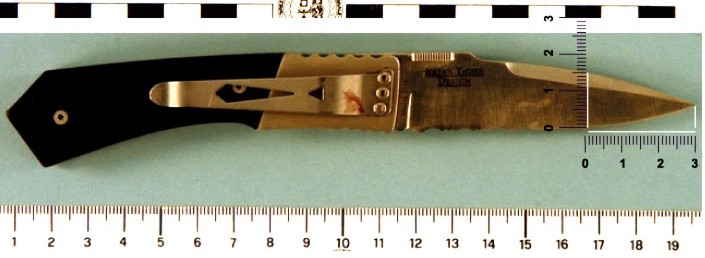
An image of Sollecito’s 2004 model Brian Tighe knife specifically made for killing people
From the Massei Report
This is from the excellent PMF translation.
P. 99: The witness (investigator) recognized it when shown Exhibit 36 as that same knife (pages 176 and 177, hearing on February 28, 2009). He remembered that in the drawer there were other knives, but he collected what was later indicated as Exhibit 36. It had the following dimensions: blade 17 cm. and handle of dark colour 14 cm. He recalled that in Sollecito’s bedroom they found another knife whose total length was 18cm, with an 8cm. blade.” (This would be his Brian Tighe pocket knife, the Spyderco flick knife was seized from his person when he was arrested)
P.135: The stab wound corresponding to the injuries on the right side of the neck was indicated as being a little wound of very small dimensions with a very small path. The path of the wound is 4cm long and only 1.5cm wide. The blade used to make this wound must have had a width of 1.5cm at 4cm from the point. This blade only entered 4cm into the neck “because it encountered the angle of the jaw” (page 33 of the transcripts).
P.147: Professor Vinci testified at the hearing of August 18, 2009. He considered the subject of the “bloody stains” found on the undersheet in Meredith Kercher’s room. In relation to these stains, on the basis of graphics given in the report dated June 30, 2009, he asserted that the knifeprint found on the undersheet in Meredith’s bedroom could have been made either by an 11.3cm knife blade, or by a 9.6cm knife blade together with a mark 1.7cm long left by the handle of the same knife. In either case, the blade could not be wider than 1.3/1.4 cm. (Ahem)
P. 154: Prof Cingolani: He clarified that irregularities present on the blade, on the edge of the blade, could have created the rippling in the wounds.
P. 157: the examination of the wound on the right part of the neck, which had absolutely incompatible dimensions: 1.5cm long and 0.4cm wide with a depth of 4cm.
p.164: she was therefore struck on the right latero-cervical region with a single-edged blade which produced a wound with dimensions of 1.5cm by 0.4cm, with a penetrating depth of 4cm: an action not relevant in determining the cause of death but intended, as before, to subdue Meredith Kercher’s resistance.
p.166: the width of the (kitchen knife) proximal third [blade one third of the distance from the handle] is 3cm.
p166: Along the edge, there was evidence of irregularities in the form of thin ridges at 2.2cm and at 11.4cm from the tip.
p. 167: The experts and consultants who were examined during the course of the trial, taking into examination the various wounds present on the neck, excluded the compatibility of the knife Exhibit 36 and the wound inflicted on the right latero-cervical and having the following dimensions: 1.5cm by 0.4cm, with a depth of 4cm in an oblique upwards direction. They in fact showed that the confiscated knife, at a distance of 4cm from the tip, has a width of approximately 3cm and thus almost double the 1.5cm width of the wound, a width thus incompatible with the dimensions of the blade of this knife.
p.172-3: In relation to the above, the thesis of the incompatibility of the most serious wound and the knife Exhibit 36 is held to be unacceptable, though this knife is incompatible with the 4cm-deep wound, as we have seen. Nor does this conclusion contrast with the circumstances illustrated by Sollecito Defence consultant Professor Vinci in his report relating to the “šanalyses of the haematic stained shapes discovered on the mattress cover in Meredith Kercher’s room”›.
p.175: The reconstruction offered by Professor Vinci certainly appears suggestive. Some doubt remains in the reconstruction of the dimensions of the knife derived in relation from the marks found on the bed sheet. If these marks indeed derived from the knife placed on the bed sheet, then they should in fact have been more abundant, and should have outlined the shape of the knife with greater precision, for the following reason: the knife, if it was placed on the bed sheet, was placed there immediately after it had been used to strike Meredith; therefore, the fresh and abundant bloodstains present on the blade should have been imprinted onto the bed sheet in a more evident and copious way than is actually appreciable. It cannot in any case remain unobserved that, if one of the knives used had a blade length of 11.3cm, or else 9.6 cm ““ according to what was indicated by Professor Vinci in the conclusions to his report ““ the argumentation set forth to sustain the incompatibility of the knife Exhibit 36 would not, on this alone, have any foundation.”
For the record, here are the paragraphs from the English translation of the Massei Report where Patricia Stefanoni describes the streaks and scratches on the double DNA knife and locations where samples were taken.
Judge Massei (on pg. 196) wrote about forensic expert Patrizia Stefanoni:
“She specified that trace B had been taken from a point on the face of the blade; she added that no biological trace was visible to the naked eye. However [she added that] “under considerable lighting, a series of streaks were visible to the naked eye. These streaks ran parallel to the upper part of the blade, therefore, more or less, they were parallel to this side [of the blade] and towards the point they went downward and, therefore, they followed the shape of the point. These streaks, anomalies in the metal, were visible to the naked eye under intense lighting” (page 95 of the transcript). Still in regard to the visibility of these streaks, she specified that they were “visible under good lighting by changing the angle at which the light hit the blade, since obviously the blade reflects light and thus creates shadows, making imperfections visible”.
The samples taken from the handle, in the points indicated with the letters A, D, F were taken in order to verify the possible presence of DNA by the person who grasped that knife. In particular, for sample “A”, a particular point had been chosen, “in which there’s the hand-guard” (page 95) and therefore, in all likelihood, the point where there was the most friction between the hand that grasped the knife and the handle. This sample yielded the result of Amanda Knox’s genetic profile.
The other samples yielded negative results, except the one taken from the blade, from the “scratches and streaks visible under good lighting, by changing the angle of the lighting with regards to the blade” that yielded the genetic profile of the victim (page 96 hearing May 22, 2009).”
And now we know: Dottora Patrizia Stefanoni got it right.
And some disagreement amongst the experts: p.291-2: Professor Cingolani had in fact noted and declared the following: “in the second lesion, the one that is 2 centimetres deep and 1.5 centimetres wide from corner to corner, the only thing that we are tempted to do, [albeit] in an absolutely amateurish/unprofessional way, because we only have photographs available, is to measure, assuming that only the tip entered, how wide the blade is [at a point] 2 centimetres from its tip: it is precisely 1.5 centimetres wide!”

A closeup with measurements of Sollecito’s Brian Tighe knife made for killing people
My own investigation
Here is my initial close examination first posted on PMF dot Net last summer.
Ergon Post subject: INVESTIGATION OF THE KNIVES USED IN THE MURDER Posted: Sun Jun 09, 2013 12:42 am
Investigation into the death of Meredith Kercher-THE CAUSE OF DEATH AND THE MEANS BY WHICH IT WAS OCCASIONED
The murder of Meredith Kercher was particularly bloody and brutal. Reading through Massei, pages 109- SURVEY AND EVALUATION OF THE FORENSIC RESULTS through to 158-173, THE CAUSE OF DEATH AND THE MEANS BY WHICH IT WAS OCCASIONED we are reminded of the brutality with which the attack took place, the sexual assault by more than one person, the restraining, the defensive wounds on Meredith’s hands, the torture by more than one knife, restraining by a hand over the mouth when she screamed, (even while she bled to death) and two major knife wounds, one to the left of the throat, the other, to the right. Massei rightly concludes, as did the Supreme Court, that more than one attacker was involved, and, per Massei, there was more than one knife used in the attack. The defense experts tried to draw attention away from the kitchen knife, but, reading through Massei again, I saw how they dropped clues to what the dimensions of the second knife might have been.
We know that Raffaele Sollecito had a fetish for violent porn, that he had an expensive collection of knives, and his many alibis for the night in question have been thrown out by the court. From my studies of criminal psychology, from reading both Amanda and Raffaele’s books and watching videos of their court appearances and television interviews, their psychopathology seem apparent not only to my eyes, but even to the general public that must have looked at them and decided their story somehow did not ring true, and refused to buy their books. There are indeed certain neurological deficits apparent in their demeanor that renowned German neurologist Dr. Gerhard Roth postulates shows up as a ‘dark patch’ in brain scans of all those who display criminal behaviour, and even, “The second type is the mentally disturbed criminal who looks at his world as threatening. A wrong look, one false move, he can explode and become a killer,” he said.
I was shown videos of the crime scene, and able to observe the wounds in Meredith’s neck. The scenes of the room in which the murder took place and, the neck wound, were truly horrifying to me, and showed the extent of the attack. Those images still sit in the mind, but also, cause me to want to get to the bottom of this mystery, hence, my work on the case.
I believe, observing the photos I already posted in the Evidence Files that the kitchen knife was the murder weapon that struck the fatal blow that night. I also believe, reading the pathologist’s report, that the blade that was stuck in Meredith’s neck, in the right latero-cervical area to a depth of 4 cms, was Raffaele Sollecito’s Brian Tighe pocket knife, photo also in the evidence files. Yes, no DNA or blood was sampled from it, but that only indicates it was successfully cleaned that night. My reading of Sollecito’s pathology is that he would not want to dispose of the knife he used, it being very expensive and also as an extension of his fetishistic ego. One other thing I asked to look at: The high resolution photos I posted of the bed show the outline and dimensions of two knives. I believe that both images are of the kitchen knife that struck Meredith in the left latero-cervical to cause a cut of 8-9 cms in depth, and a length of 8 cms (p. 167)
There are two exhibits of the mattress cover, one marked “J” and the other, “O”, both displaying the approximate size and dimensions of the kitchen knife, which I will explain when I post the photos. The first, “J”, has more blood because I believe the knife was placed there first and wicked on to the sheet, causing the distorted splotch at the end. By the time it was moved to its final position by the purse, “O”, it retained just enough blood to leave a clearer, indelible impression.
It was a butchery.”
One last point: Rep. 33A/B/C/D were four samples taken from a black-handled folding knife. It tested negative for blood, but, in one sample, the DNA profile matched a mix of Knox and Sollecito. The other samples were negative. Stefanoni: pp. 103-104
Looking at the images produced by my illustrator, and taking the average of the two estimates of the wound depth, 2 and 4 cms, one arrives at a blade width of 1.5 cms at 3 cms length from the tip of Raphaele Sollecito’s Brian Tighe collectors knife, on which, coincidentally, both Amanda Knox and Sollecito’s DNA was found.
Conclusion:
Raffaele Sollecito stabbed Meredith Kercher, causing the lesser wound. And my personal opinion? It was with the Brian Tighe knife, and somehow both he and Amanda Knox got their DNA on it around the same time that night.
Monday, January 27, 2014
An Investigation Into The Large Knife Provides Further Proof That This Was THE Knife
Posted by Ergon
Overview
This is the first report of an investigation (the second part follows soon) of the kitchen knife used in the murder of Meredith Kercher, RIP.
Specifically its compatibility with the imprint of a bloody knife found by police investigators on her bed under-sheet which as you will see here seems possible to prove.
Two other recent posts also concentrated on aspects of the knife as strong proof: (1) proof of both Knox and Kercher DNA and (2) proof from the throat wounds.
- Reference files are from very high definition crime scene photos not in general circulation.
- Grateful thanks to the volunteers of the Meredith Kercher community who assisted in this production
Florence Court of Appeals
This is our poster Machiavelli, tweeting from the Florence courtroom on November 26, 2013:
“(Prosecutor Alessandro) Crini stated that this kitchen knife was compatible with the knife print on Meredith’s bed sheet”.
And this is from the defense summing up on January 09, 2014:
Bongiorno: “It’s too big, not the murder weapon.”
“Bongiorno shows a picture with an envisioned “knife” (pocket knife belonging to Guede?) together with the print on the bed sheet.”
“Nobody brings a “small blow with a big knife” “You don’t use half of a big knife” (she says)
Genesis of an investigation:
To recap: evidence was been presented at the Massei court of the first instance, which accepted that the kitchen knife, containing both Meredith Kercher’s DNA on the blade (trace B) and Amanda Knox’s DNA on the handle (trace A) was the weapon that struck the fatal blow to Meredith Kercher’s throat.
At some point after the attack, the perpetrator, Amanda Knox, puts it down on the bed, leaving “hematic stains” (bloody imprints) on the mattress.
The court concludes the shape of the imprints are compatible with the kitchen knife. It also concludes, based on the size of a lesser wound that a second, smaller knife caused the wound on the other side of the neck, and, the impossibility of accepting that a single weapon inflicted both wounds.
This is what it boils down to now, as we come to the final arguments of this case on January 30, with a decision to be handed down by the court later in the day:
- Was the kitchen knife found in Raffaele Sollecito’s kitchen the murder weapon that killed Meredith Kercher on November 01, 2007?
- Did the killer leave behind proof in the form of bloody imprints on the under sheet covering Meredith’s bed?
- And is the defense trying to divert attention away from it, even though the image on the bed fits the dimensions of the kitchen knife?
- And pointing to a second knife, not ever found?
This article (to be followed by part II) was prepared to offer answers to these questions.
Methods used
As someone with a keen interest in photography, I know we see things in photographs that are not always apparent to the naked eye.
Where before we had all been misled by low definition photographs released by the defense to obscure incriminating details, I was able to obtain and view the high definition photographs shown here that proved that indeed, the bed imprints matched the seized kitchen knife, exhibit 36.
These photographs, first posted at Perugia Murder File Evidence Files have been circulating for some time, with members trying to match the knife to the bed imprints, but not, in my opinion, being able to match it exactly.
First, note that the killer placed a knife on two separate locations on the bed, marked by reference cards “J”, and “O”. (Reference photos below.)
I discarded “J”, because there was too much blood there to form an accurate measurement. The killer lifted the knife and then placed it at “O”, which gave a better image, but even then, did not match exactly. Still, it was clear the images looked like a kitchen, and not, a pocket knife as alleged by the defense.
Looking at the reference photo, I saw a double image of a knife blade at “O”. (see where there’s a curved edge of the blade? That’s what convinced me there might be a double image there)
Conclusion reached
My opinion is the knife shifted slightly when it was placed there, hence the double image, which now made a perfect match with the kitchen knife, in both instances (see reference photos).
So I got a professional illustrator and other skilled people people to do the scale drawings and produce the video you see above which seems to provide conclusive proof the murder knife was placed on the bed.
Reference photos:
Image 1 above (click for larger image): Bed II (Image J and O on under sheet, shot November 02, 2007)
Image 2 above (click for larger image): Knife II (Image O on under sheet, shot November 02, 2007)
Image 3 above (click for larger image): FOTO5BIS (Conti-Vecchiotti lab, Mar. 22, 2011)
Image 4 above (click for larger image): Knife-Bed-Vector-AllScales (To prove the scales used to match the images)
Image 5 above (click for larger image): Knife-pos-lower-hi (The knife’s first resting position at “O”)
Image 6 above (click for larger image): Knife-pos-upper-hi (The knife’s final resting position at “O”)
Next steps
There are only four more days left till the Florence Appeals Court under Judge Nencini issues its verdict. It must of course consider ALL the evidence, of which there is a preponderance that indeed suggests the verdict will, as would be proper, be guilty as charged.
Part II will be ready ASAP. It will be a recap of Massei on the knife, and how the defense continually tried to divert us away from the knife image by saying it did not fit the dimensions of the major wound. Also will have Frank Sfarzo’s misdirection and Bruce Fischer’s amateurish attempts to prove that Rudy Guede caused the knife wounds.
Happy as always to do my share for justice for Meredith Kercher.
Monday, November 25, 2013
Appeal Session #4: Today Lead Prosecutor Alessandro Crini Summarises The Prosecution’s Case
Posted by Our Main Posters
Overview
This is the report on the first day of Prosecutor Crnini summarizing the entire case.
This was not attempted at such length at the 2011 Hellman appeal and that panel of judges was perhaps not ever fully in the picture. The second day of the presentation is reported on here.
Real-Time Reporting, Bottom-Up
5. Good reporting on the court today
Andrea Vogt has posted an objective report here and Barbie Nadeau an objective report here. We will post excerpts from both and other sources after the appeal session on Tuesday is done.
5. Warning about AP’s Colleen Barry
The Associated Press’s Colleen Barry is once again filing highly biased reports from the court. This is an appeal by Knox and Sollecito AGAINST a guilty verdict (by Judge Massei) and not an appeal by the prosecution to “reinstate” a guilty verdict. Get a grip.
4. Final post from the court today
It is 5:30 pm in Italy. Judge Nencini has declared today’s session at an end and he has allowed the prosecution to resume its presentation tomorrow. Prosecutor Crini has about 1/3 of his presentation on the evidence still to come.
3. Tweets from main poster Yummi
Yummi has warned us that the wireless internet bandwidth inside and just outside the courtroom gets overloaded late in the day as the reporters get busy on their reports. Yummi does have a way around this but it involves leaving the courtroom when key arguments might be made and walking some distance away. So there might be some slight delays.
[More pending; Dr Crini has alerted that his presentation will be in 16 chapters]
51. [Judge] Nencini suggests to interrupt and go on tomorrow with following prosecution’s points. New schedule.
50. Chapter 11. is DNA. Crini says we may have evidence enough by now anyway
49. Crini censures Hellmann-Zanetti’s reasoning about calunnia (why not indicate the real culprit?). Says H-Z committed ‘physical violence’ on trial file
48. Knox’s calunnia is a strategy protracted over time says Crini
47. Dreamlike component in Knox’s statement, fish blood, are devices needed to surround a calunnia strategy
46. Knox needed to put some additional content into the ‘calunnia’, says Crini, or wouldn’t be believed, so she puts in pieces of truth
45. Knox spoke about a scream an a sexual violence before anyone knew. Sollecito said nothing was stolen before they knew.
44. Points out Sollecito says Romanelli’s door was wide open; Knox doesn’t notice theft. Crini highlights the ‘combination’ of inconsistencies
43. Knox thinks locked door is normal; does not flush toilet when finds feces; does not notice blood before having a shower; thinks blood is ok
42. Notes Knox’s statements are inconsistent and ommisive before her interrogation.
41. Crini speaks about Knox’s declarations. Interested in the timings. Says too much was repeated to be coerced.
40. Crini speaks about chapter 9, the statements of Sollecito. His call to her sister. His alert was late but even so preceded the postals arrive
39. Bathmat print and luminol prints were chapter 7. of Crini’s argument; 8. is the staging of theft.
38. The most significant stain may be the one in Romanelli’s room, says Crini.
37. Speaking of a female’s print left in luminol, Crini sounds outraged, saying other substances is vague unsubstantiated conjecture [eg it was blood not bleach]
36. Guede’s sentencing was not well calibrated says Crini. But a Guede alone scenario is not tenable
35. Does it make sense for Guede to leave there the evidence of (putative) theft, and clean footprints?
34. The unitary sense made by elements like the bloody print, is a cleanup. Considers the lone-perp scenario: inconsistent
33. Crini: starts talking about the isolated bloody print; calls it a ‘talking element’. Why is that print alone?
32. Suspects are only ones with a ‘logistic’ capability and an interest to ‘clean’ the murder scene. They aimed at ‘diminishing’ the evidence mass
31. Knox’s lamp was the only light in her room.
30. Crini: the perp(s) organized a rather complex plan to clean up and ‘sidetrack’ at the murder scene.
29. Still to be determined if calunnia was “occasional” due to pressure, or “aggravated” [sidetracking]; Crini saya a ‘depistaggio reale’ (sidetracking) occurred
28. Crini: suspects’ statements are extremely interesting: RS’s statements; AK’s e-mail, internet statements, [Knox’s] memoriale
27. Crini: a most fertile chapter of analysis is the ‘post-factum’ actions and behaviors of defendants
26. Crini has unfolded five chapters. Says he has a total of sixteen
25. Quintavalle, details of his testimony and woman’s description are exceptional indicators of accuracy.
34. Crini: it is unlikely that Quintavalle got it wrong. Because of contextual elements.
23. It is incorrect to dismiss a witness a priori because late. But for reasons totally different. Sometimes late is symptom of reliability.
22. Wants to deal with the issue of the fact that he came forward late, urged by an acquaintance
21. Crini: fifth argument is Quintavalle. He says he is sure about his testimony. Is a different kind of witness
20. Crini accepts both alternatives on time of death, after 23.15 or before 22.30 (but seems to prefer the earlier one)
19. Crini: Do not overestimate importance of timings that are not anchored accurately or cannot be proven
18. Crini: timeline is marginal to the case. All unproven timings to be taken cautiously.
17. Crini starts fourth theme: timings. Says they are very vague, except the tow truck
16. Crini: Curatolo is no ‘super-witness’, but can contribute to helping the court to draw their scenario
15. Curatolo saw a couple discussing and this memory is very specific, peculiar
14. Curatolo did not confuse night with Halloween, because it was big party in piazza the previous night, and because it did not rain
13. Crini: the court saw Aviello, shows what top [level] of unreliability is; the SC suspected so unreliable that calunnia elements had to be assessed
12. Crini: many trials could not exist if drug addicted testimonies were dismissed
11. Crini: the H-Z court assessed Curatolo a priori based on him as a person, stemming from questions of the court itself
10. Crini about Curatolo, describes Piazza Grimana; he was an habitual presence of the piazza, proven reliable in other cases
9. Crini: computer records and alibi point to Sollecito being not at home but on murder scene
8. Crini cites the log files of Fastweb: no internet activity, only automatic connections.
7. Crini: failure of computer alibi is evidence against, not just lack of confirmation.
6. Nencini notes prosecution did not ask to interrogate Sollecito. Crini cites D’Ambrosio’s computer expert report. No interaction before 5am
5. Sollecito gave computer alibi days later, and words his statement in the singular form.
4. Crini: first theme he deals with is presence of crime scene; alibi, if it’s false it is evidence no matter why false (cite from Guede trial)
3. Crini attacks the method of logic reasoning of annulled appeal: parceling out evidence, parrots aspects of civil procedure
2. Crini: Supreme Court censure was against the foundations of appeal , all parts not just some errors; appeal was ‘razed to ground’.
1. Crini: this appeal is unusual, not because of the case but for the course followed. Usually appeals are narrow, this SC annulment is not.
2. Tweets by Andrea Vogt
3. At Crini’s side in amandaknox appeal today is veteran Florentine prosecutor Tindari Baglione. Before this, he was in Cassazione.
2. Prosecutor Crini in Florence: don’t repeat error of Perugia appeal. Consider evidence wholly, including Curatolo.
1. Will prosecutors ask life sentences in amandaknox appeal today? Will Sollecito’s presence in court benefit him? Verdict January 10.
1. Prosecution Begins
This is the prosecution’s day. Sollecito is reported as being in court but low-key.
Various reporting notes the significant presence of Dr Tindari Baglione, formerly with the Supreme Court, about whom we posted on in September as follows:
The new Prosecutor General of Tuscany (Florence’s region) Dr Tindari Baglione, the chief prosecutor of Tuscany’s appeal court, is selecting the prosecutors for the appeal. He arrived in Florence in May of this year. He is said to be formidably unbending. He recently imposed tough sentences on 27 people for the environmental damage caused by illegal work in Mugello on the high speed rail link between Florence and Bologna.
Tuesday, November 12, 2013
Differences Between Micheli, Massei, Hellmann and Nencini Courts Pointing To Almost Certain Outcome
Posted by Peter Quennell
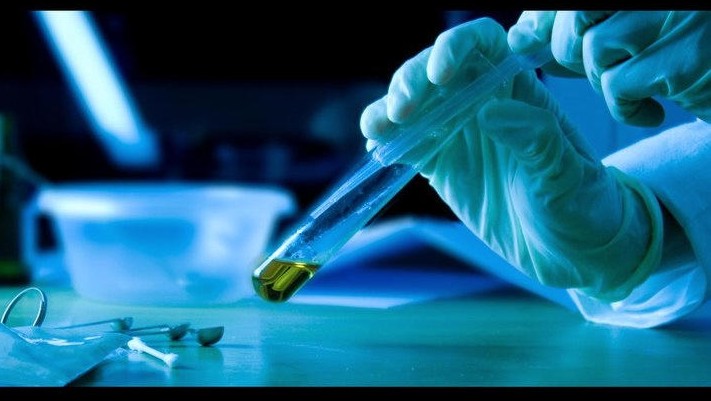
What are the biggest differences? In fact the Supreme Court already pointed them out: science, scope, and balance.
Judge Micheli, Judge Massei and Judge Nencini all have a very extensive criminal-case background. All three have handled many cases of murder, many cases against the mafia, and many cases involving criminal science. All three have remarkable success records and have hardly ever been overturned on appeal.
Judge Hellmann and his court are the extreme outliers. Until forced into early retirement by the Council of Magistrates, he had been a (quite good) business judge. His one major criminal case, years ago, had led to a farcical outcome, and he was ridiculed for this at the time.
Cassation made it very clear that he simply did not reflect a knowledge of the precise Italian law on scope and balance at the appeal level, and that he mishandled the science. In fact, as he actually said, the reason he appointed two independent DNA consultants was that he was at sea on the science.
That left Judge Hellmann’s panel of judges like a rudderless ship, bereft of the kind of good guidance from the lead judge on science, scope, and balance that comes only from many years of experience.
Which, given a level playing field, the pathbreaking Italian system enforces competently like almost no other.
Above all as the Hellmann Report makes extraordinarily plain, his court came to be swayed by the CSI Effect, with the help of two tainted consultants and probably the irresponsible Greg Hampikian in Idaho.
The CSI Effect is a phenomenon very, very unlikely to happen in Judge Nencini’s court. First, take a look at this good explanation of what the CSI Effect is in the Fox Kansas City video.
Many crime shows such as the BBC mysteries and the Law & Order series and spinoffs show investigators solving their crimes in the old-fashioned way. Lots of witness interviews and alibi and database checking, and walking around and loose ends and lying awake at night puzzling. And often there’s a big stroke of luck.
But if you watch the very popular CSI Las Vegas series and its spinoffs in Miami and New York, and the various clones on other networks, you will see something very different indeed.
When those shows first began airing worldwide in the late nineties, the producers explained that audiences increasingly appreciate learning something new when watching a show, and it is true, one sure can load up on the trivia.
But you will also see the US equivalent of Dr Stefanoni and her forensic team in those shows, roaming far beyond the narrow crime scene, interrogating witnesses and checking alibis and finding a lot of non-forensic evidence, and even at times drawing guns.
Most unreal is that, time and again, the forensic evidence testing is clearcut and takes just a few minutes and instantly clinches the case.
- There are several articles like this one and this one on whether the Casey Anthony jury was affected by a shortfall in the starkness of the forensics when the behavioral evidence seemed so strong.
- There are several articles like this one and this one on whether the appeal verdict outcome in Perugia might be affected in the same way.
- There are many articles like this one and this one and this one and especially this one saying there is a tough added burden on investigators and juries without a commensurate improved outcome.
With conviction rates declining in the US and Europe, professionals are taking a scientific look at whether the CSI Effect is one big cause of that decline.
At the macro level in the US this writer doubted that the CSI Effect is fatally unbalancing takes on the wider evidence. The same conclusion was reached in this first major study at the micro level.
But the belief in the CSI Effect continues. Articles like this one on an Australian site talk of a backlash against too many acquittals. Some articles like this one argue that maybe lay juries are out of their depths.
And judges and prosecutions are taking countermeasures.
In Ohio and many other states prosecutors and judges are acting against a possible CSI Effect in their selection and briefing of juries. And an NPR report came up with these findings.
Some states now allow lawyers to strike potential jurors based on their TV habits. Judges are issuing instructions that warn juries about expecting too much scientific evidence based on what they see on TV.
In the field, Shelton says death investigators sometimes run useless tests, just to show they went the extra CSI mile.
“They will perform scientific tests and present evidence of that to the jury. Even if the results don’t show guilt or innocence either way, just to show the jury that they did it.”
This is coming at a time when death investigators in America have no resources to spare. An investigation by NPR, PBS Frontline and ProPublica shows some states have already opted not to do autopsies on suicides, others don’t autopsy people who die in traffic accidents, and many don’t autopsy people who die over the age of 60.
But Murphy, the Clark County coroner, expects things to get worse.
“You know, we’re in budget cuts right now. Everybody’s in budget cuts. Las Vegas is no different than anybody else. We’re hurting. We’re going to feel that same crunch as everybody else,” he says.
One of Zuiker’s great disappointments is that, for all its popularity, his fictional Las Vegas crime lab didn’t generate more political support to fund death investigation.
“I’ve done my job. You know, we’ve launched three shows that cater to 73.8 million people a week and is a global phenomenon and the largest television franchise in history. We hoped that the show would raise awareness and get more funding into crime labs so people felt safe in their communities. And we’re still hoping that the government will catch up.”
None of the science in Meredith’s case has ever been discredited in court. Even in Judge Hellmann’s court the agenda-driven independent consultants Conti and Vecchiotti failed - and under cross-examination admitted it.
Also remember that the Hellmann court did not get to see two very key closed-court scientific presentations (the stark recreation of the attack on Meredith, in a day of testimony, and later in a 15 minute video) which had a very big balancing effect on the Massei court.
Right now the reputation of not one defense-campaign stooge who has attacked the science remains intact.
Greg Hampikian has headed for cover. He had widely proclaimed that he clinched the Hellmann court’s outcome, in an act which may well have been illegal. Unsurprisingly, he is now trying very hard to hide his own claimed “proof ” of shortfalls in the science, as Andrea Vogt has been showing in her Boise State University investigation, and as we will soon post more on.
Saul Kassin is another defense-campaign stooge who falsely claimed that he clinched the Hellmann court outcome by “proving” a false confession by Knox - in an interrogation that never even took place.
Despite all of this, maybe as straw-snatching, we can again see an organized attempt to confuse American opinion on the science of the case.
Whether she did this intentionally or not, that is what the PR tool Colleen Barry of the Associated Press was doing when she omitted that the trace of Meredith on the knife is undisputed hard evidence.
Judge Micheli and Judge Massei handled the science, scope, and balance with some brilliance. In all three dimensions Judge Hellmann fell short abysmally.
What is your own bet on the outcome under the exceptionally experienced Judge Nencini?
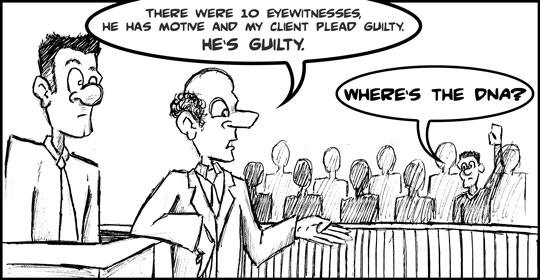
Parts of this post were first posted in 2011 after the disputed and much examined outcome of the Casey Anthony murder trial..
Sunday, November 10, 2013
The Crime-Scene Clean-Up: How Rudy Guede’s Diary Provides Even More Proof That It Happened
Posted by pat az
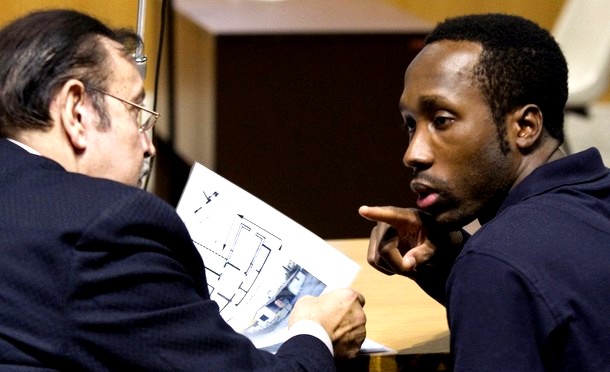
This post is crossposted from my own place. Here is one of my previous crime scene analyses on TJMK.
Rudy Guede was ultimately declared convicted by the Supreme Court in 2010 of participating in the 2007 murder of Meredith Kercher.
The prosecution claims the two other participants are Amanda Knox and Raffaele Sollecito. Knox and Sollecito are currently appealing their conviction of the same crime.
The case against the three of them involves a suspected clean up of the hallway in the apartment after the crime. Meredith’s blood was found in the bathroom, and half a footprint in her blood was found on the bathroom mat. However, there was no visible blood between Meredith’s bedroom and the bathroom.
The only visible blood in the hallway were faint partial shoe prints that led directly out the front door of the apartment.
After the murder was discovered, the media reported almost daily on developments in the case. The day of the murder, the press reported on the blood found in the bathroom and the bedroom.
But until police used luminol at the apartment on December 18th, the media didn’t report on any significant blood found in the hallway. Between November 2nd and December 18th, only one person stated that significant amounts of blood had been in the hallway.
Rudy Guede.
Rudy Guede actually wrote about it in his diary between Nov 20th and Dec 6th, after being captured in Germany.

The police arrived at the apartment on November 2nd. According to media reports, the blood they spotted immediately was only in the bathroom and Meredith’s bedroom. When the scene was more closely examined, after the discovery of the body, police found visible blood patterns on the floor left by Guede’s left shoe as he left the apartment.
None of the people who arrived in the apartment on the afternoon of November 2nd reported seeing them; these footprints are not in any of the stories of the events of Nov 2nd told by Amanda Knox nor Raffaele Sollecito. So, while these prints were visible, they were not substantially obvious.
On December 18th 2007 investigators applied Luminol in the hallway and other bedrooms. This forensic chemical is used to detect blood which has been cleaned away. The Luminol revealed several footprints in the hallway between the bedrooms of Knox and Meredith. Example below. Some of these footprints were leading towards Meredith’s door.
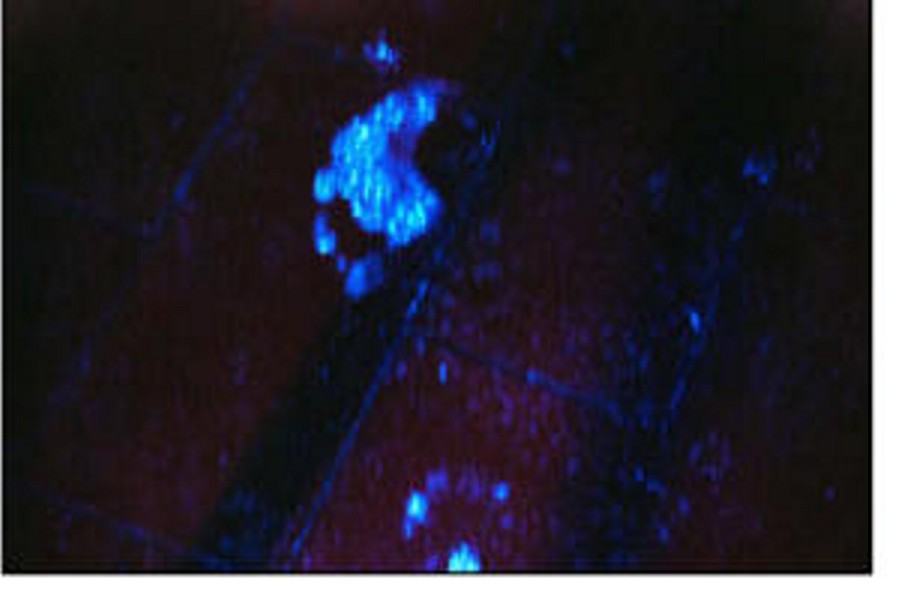
They also discovered prints in Filomena’s room which contained Meredith’s DNA and Amanda Knox’s DNA. They also revealed a footprint in Amanda Knox’s bedroom. (The defense unsuccessfully contested the investigator’s conclusions that these prints were made with blood).
On November 19 2007, an international arrest warrant was issued for Rudy Guede. He was arrested in Germany on November 20th. Guede remained in Germany until his extradition on December 3rd.
During his stay in jail in Germany, Guede wrote a long statement that was published and translated. Guede’s writings are similar to to Knox’s jail writings in many ways - they both try to write out their own detailed version of events, while pointing blame elsewhere.
But Guede’s comments may in fact be confirmation of a clean-up after the murder of Meredith Kercher (emphasis added):
I am asking myself how is it possible that Amanda could have slept in all that mess, and took a shower with all that blood in the bathroom and corridor? (Guede, Germany Diary, P21)
The police did not find evidence of any other blood until December 18th, AFTER Guede returned from Germany. As indicated above, the luminol revealed multiple footprints in the hallway, in Knox’s bedroom, and in Filomena’s bedroom. The image below shows these results in blue. Guede’s partial footprints are shown in red.
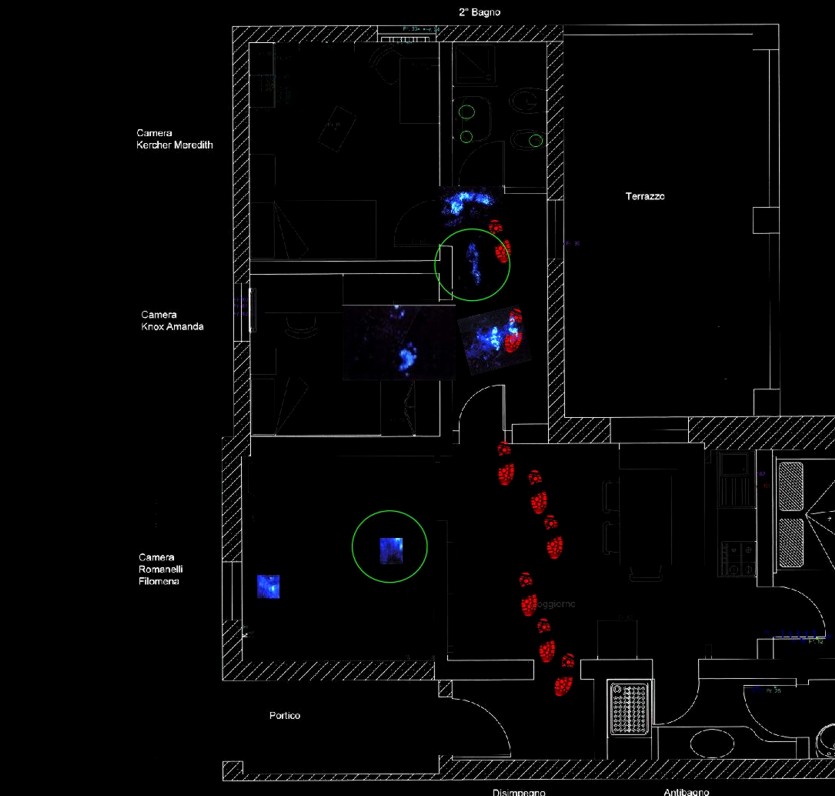
The conclusion is inescapable: Guede knew there would be significant evidence of blood in the hallway, before the police themselves found that evidence.
How did Guede know there would be more blood found in the hallway, before the police found that evidence on December 18th? And why wasn’t that blood there on the morning of November 2nd?
The courts believe the blood in the hallway was cleaned after the murder of Meredith Kercher. And the Micheli and Massei courts believed only one person had the motivation to hide this evidence: Amanda Knox.
Here is a summary of Judge Micheli’s October 2008 indictment finding.
In Judge Massei’s December 2009 trial finding for the original conviction of Knox and Sollecito, he also writes about the clean-up that the judges believed to have happened:
Further confirmation is constituted by the fact that, after Meredith’s murder, it is clear that some traces were definitely eliminated, a cleaning activity was certainly carried out. In fact, the bare foot which, stained with blood, left its footprint on the sky-blue mat in the bathroom, could only have reached that mat by taking steps which should have left other footprints on the floor, also marked out in blood just like (in fact, most likely, with even more [blood], since they were created before the footprint printed on the mat) the one found on the mat itself. Of such other very visible footprints of a bloody bare foot, on the contrary, there is no trace. (Massei, Dec 09; PMF translation)
In defense of Guede, Knox, and Sollecito, some might try to claim that Guede heard about blood in the hallway in the news. Rudy Guede was arrested 18 days following the murder of Meredith Kercher. During that time he had access to read the news and watch reports.
I have searched for articles in the period between November 2nd and December 18 which mention blood. All of the articles I have found so far discuss blood in the bedroom or the bathroom. One or two discuss footprints leading to the front door.
None of them discuss blood in the hallway that would justify a statement from Guede of “tutto quel sangue nel bagno e sul corridoghe” (all that blood in the bathroom and in the corridor)
Guede himself said he went between the bedroom and the bathroom, so may have tracked blood into the bathroom and therefore known blood would be found in the hallway.
Even that knowledge however confirms a clean-up, as there was not a trail of blood between the bathroom and Meredith’s room that justifies the footprint on the bathmat and blood found in the bathroom.
I have my own questions as a result of Guede’s knowledge of blood in the hallway:
Could the attack have started in the hallway? Could the first blood shed have been on the hallway tiles?
The prosecution and courts argue that Amanda Knox had a role in the attack and murder. Knox and her supporters are very adamant that there is no trace of Knox in Meredith’s bedroom. While the courts argue otherwise, could Knox’s role have been limited to the hallway?
Sadly, we may never know the full truth of what happened on the evening of November 1st, 2007.
My timeline of media reports on blood
- Nov 2nd: Meredith Kercher found. Blood found in bathroom.
- Nov 5th: Police analyzing traces of blood from apartment below.
- Nov 5th: A “trail of blood” is on the inside handle of the door to the apartment.
- Nov 7th: reports of Amanda Knox’s statements, includes finding blood in the bathroom.
- Nov 14th: Police use of Luminol at Sollectio’s house. First reports on the knife seized by police from Sollecito’s house.
- Nov 19th: Analysis of blood in bedroom (pillow, bra, etc).
- Nov 22nd: Guede’s prints in blood.
- Nov 27th: Amanda Knox’s blood on bathroom tap.
- Nov 28th: Blood in bathroom.
- Dec 5th: Reports of Guede’s letter to father: “there was so much blood”.
My timeline of main events involving Guede
- Nov 2nd, 2am ““ 4:30 am: Guede seen by witnesses at Domus nightclub.
- Nov 3: Guede leaves Perugia for Germany
- Nov 11: Guede’s cell phone tracked in Milan (Corriere)
- Nov 12: Newspaper reports a 4th suspect.
- Nov 19: Guede identified as suspect in newspapers
- Nov 19: Guede skype conversation with friend.
- Nov 20: Patrick released from prison.
- Nov 20: Guede arrested while trying to return to italy on train in Germany.
- Nov 21: Guede interrogated by German police; Guede admits to being at apartment, blames an italian man for murder.
- Nov 20-Dec 5: Guede writes diary in German prison.
- Dec 3: Germany grants Guede’s extradition back to Italy.
- Dec 6: Guede returns to Perugia.
- Dec 7: Guede interrogated by Magistrate.
- Dec 14: Guede ordered to remain in prison.
- Dec 17: Knox is questioned by Mignini.
- Dec 18: Police use luminol in apartment and find footprints in hallway and in Filomena’s bedroom.
Wednesday, November 06, 2013
Appeal Session #3: The Carabinieri Labs Report On The DNA On The Knife
Posted by Our Main Posters
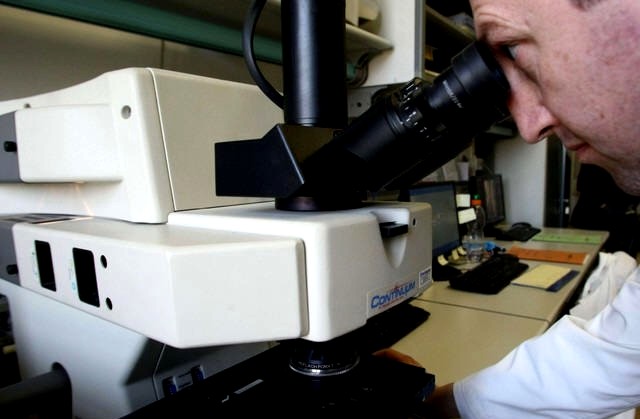
[Above: an image of similar testing in the same Carabinieri laboratory in north Rome]
Final Update
So the court session does not even extend beyond the lunch hour. Good morning Seattle! At this moment it is still only 3:30 in the morning there. Only night owls will know what happened.
Yummi and Mason2 may have more for us, which will appear either here below this final update on in Comments. Also Andrea Vogt and hopefully Barbie Nadeau will be filing longer reports in English. We will also check out all the Italian reporting.
Hard to see any game changers in today’s strong but undramatic testimony. The Carabinieri RIS DNA experts could not be shaken. All momentum remains with the prosecution and with the Supreme Court’s “givens” on the evidence, such as the presence of three attackers in Meredith’s room.
The defenses seem to be giving up. They could have phoned it in. Sollecito lawyer Bongiorno didnt make any new fuss. And Amanda Knox lawyer Dalla Vedova was cut off by the lead judge several times, for trickily going off the point. He really is out of his depth in a criminal trial; at the same time often condescending.
And a seeming big slap in the face for the American defense stooge Greg Hampikian who seems to have illegally colluded with the disgraced Hellmann consultants Conti and Vecchiotti (who were not even mentioned today) when Judge Nencini asked Dr Barni “Would you be able to provide reliable standards without using suggestions from Americans?” Dr Barni responded “Of course”.
And Sollecito “wasted” his statement by whining about his life, showing no compassion for Meredith (despite his claimed visit to her grave), and not answering any of the dozens of open questions. Sollecito really needed to show he is both strong and compassionate and NOT a weakling under the thumb of Amanda - but he seems to have done quite the opposite. The family lawyer must not be too pleased.
Fifth Update
The opening of Frank Sforza’s trial in the same courthouse is postponed, apparently because new information on his campaign to poison opinion against the judiciary and his unsavory connections has been coming in.
Information will be exchanged that is gathered at this trial on mafiosos Luciano Aviello and at Aviello’s own trial for obstruction of justice which is now proceeding in the same Florence courthouse in parallel.
The findings and possible charges on the defamatory and dishonest books by Knox and Sollecito are due about now from the Florence and Bergamo prosecutors. Information gathered in those investigations could also be fed in to this process, or put aside for separate trials.
As both the AK and RS books are bulging with the standard PR talking points (some of which flowed from Frank Sforza and Doug Preston) in a sense it will be Curt Knox, the Mellases, Marriott, Sforza, Fischer and Moore who will be put under the microscope.
Fourth Update
A more detailed report on the DNA phase today from the Andrea Vogt website.
The RIS Wednesday deposited their forensic report on trace 36i, a spot of DNA identified (but not earlier tested) on the kitchen knife alleged to be the murder weapon. “Cento Percento” (100 percent) said Major Berti, discussing compatibility. The RIS found that the DNA was compatible with Amanda Knox, and excluded that it was that of Sollecito, Guede or Kercher.
The RIS expert was asked only a few questions from attorneys and the judge. The judge asked why the RIS had done two amplications of the DNA and not 3 or 4. Major Berti described that two is considered the minimum number of amplifications necessary, according to today’s forensic standards, doing less (or more) might have diminished the reliability of the results. The judge also asked about the age of the equipment used. Berti responded that the forensic kit used this time has been commercialized since 2010 and available for use since 2011.
At one point the judge stopped a line of questioning by Knox’s Rome attorney Carlo Dalla Vedova, who was asking why the RIS described Knox’s DNA as “fluids” when a prior expert had said the trace did not come from blood. Nencini said: That question was not put to the RIS by this court, it was not their job to determine that. The other experts’ reports are in the case files for everyone to read, he noted, adding: “We cannot put words in the mouth of this expert that were said by another expert.”
Third Update
Tweets from our main poster Yummi (Machiavelli)
32. Judge Nencini’s comments were always addressed at Dalla Vedova’s arguments, who was in fact a bit silly
31. The Judge declared the evidence phase closed. Next court dates are 25 November for prosecution argument and 26 for the defences with 16 and 17 December.
30. Judge Nencini asked Dr Barni “would you be able to provide reliable standards without using suggestions from Americans?” Dr Barni: “of course”
29. Dalla Vedova said Tagliabracci was the only Italian source in the RIS report, all others are foreigners, emphasized the American labs…
28. Sollecito said his family absolutely never had issues with justice. And he is a proud ‘member’ of that family
27. He also played the ‘national’ card, as he remphasized ‘I am Italian’ twice and then addressed the court ‘I am an Italian, as you are’
26. Sollecito mentioned the defens’s arguments (he has an orthopedical issue with his foot etc.).
25. The questions of all parties to the experts were intended to elicit information to be used in arguing the unrelated previous finding
24. He mentioned Meredith’s name only once, to say he barely knew her.
23. Sollecito talked with a faint voice, a long speech in which he described himself as a victim.
22. The Carabinieri say that there are only a few governmental laboratories which have the 17025 certificate (the Carabinieri and the Police)
21. Nencini stops Dalla Vedova, points out that scientific community is international
20. Dalla Vedova tries to elicit that the good standards are not the Italian ones.
19. The RIS obtained the ISO9001 certificate in 2008, and a more specific certificate in 2012.
18. Bongiorno asks RIS to explain why two amplifications are recommended.
17. Prosecutor Crini asks if there are criteria to distinguish which labs or which experts are more competent.
16. Speaking about their software which allows to weight probabilities of attribution.
15. They note that three alleles which are ‘alien’ were drop off in one duplicate.
14. The biologic method has a ‘consensus’ interpretation and a ‘composite’ interpretation, two ways to interpret the double result.
13. They describe the methods employed, the ‘biologic’ method and the ‘statistic’ method.
12. Absence of any male trace stands out as a feature of the sample (all contributors are females)
11. They extracted two profiles in a duplicate in agreement with experts of all parties
10. Dr Berti says the sample was a low template. They have a strategy to obtain reliable results.
9. Points out that documentation says sample 36i comes from insertion of blade in the handle.
8. Dr. Berti summarizes the recovery of sample in Vecchiotti’s lab.
7. Bongiorno says Sollecito intends to release a spontaneous declaration. He will do that after the experts testimony.
6. Berti and Barni enter the court.
5. Many law students from the Florence school for Magistrates are in court to follow the hearing.
4. Sollecito had managed to enter the courtroom from side entrance eluding photographers. Carlo Torre arrives in court.
3. Giulia Bongiorno & Raff kiss each other. Giulia, Raff & Father have a worried discussion
2. I wonder… will the court withdraw his passport?
1. Raffaele Sollecito is in courtroom. Walking in empty room, few people waiting. Hearing will start 1/2h probably
Second Update
Tweets from Patricia Thomas (AP) and Sabina Castelfranco (AP)
Patricia Thomas “@MozzarellaMamma: RaffaeleSollecito - Amanda Knox and I were very carefree and isolated in our love nest.
Sabina Castelfranco “@SCastelfranco: Sollecito says he is not the assassin he has been described as. Says Amanda was his first love
Patricia Thomas “@MozzarellaMamma: RaffaeleSollecito - I have been described as an assassin. Amanda Knox was my first real love in life
Patricia Thomas “@MozzarellaMamma: RaffaeleSollecito takes stand to make statement, starts complaining about media descriptions of himself
First Update
Tweets from Barbie Nadeau
35. Nov 25 - prosecution; 26 - civil; Dec 16 - Sollectio; 17 - Knox; Jan 9 - rebuttals, 10 deliberation and verdict
34. Dec. 16, 17 closing arguments for Knox and Sollecito
33. Judge closes hearing for day, says closing arguments begin Nov 25, 26, must find December dates to conclude
32. Sollecito finishes by thanking judges for their time, judge tells him he can intervene any time during rest of appeal until they deliberate
31. Sollecito says he hates the fame, how it has hurt him, how it isn’t fair
20. Sollecito says he has a difficult time looking for work, people associate him with the murder of meredith kercher
29. Sollecito says that even on his vacation in Dominican Republic, he had to defend himself like a public figure, his life is judged by all
28. Sollecito repeats twice that he never met Rudy Guede, how nothing in original trial was based on reality.
27. Sollecito takes trip down memory lane, highlights worst parts of trial and incarceration for him, has not mentioned meredith kercher yet
26. RaffaeleSollecito - I feel a persecution. It is a nightmare, beyond all imagination.
25. RaffaeleSollecito—close to tears as he testifies to court “I am fighting every day to bring out the truth”
24. Jury totally transfixed by sollecito declaration, can’t take their eyes off him
23. Sollecito thanks and defends his family, calls amand knox his first love
22. Judge asks for Sollecito declaration now
21. Judge asks about relevance of kit they used, how old technology was, etc.
20. Judge asks what minimum testing is for validation of DNA, RIS says “at least two”
19. Judge tells Dallavedova he cannot put words in mouth of new expert that were said by previous experts, this is fresh analysis
18. Judge clarifies that RIS was not asked to reanalyze work that has been done, but to test a sample that has not been tested.
17. Dallavedova essentially kicks goal into own net, not doing amanda knox any favors by making RIS defend methods used in original conviction
16. Dallavedova manages to get RIS expert to defend Italian methods, says they are in line with global standards, this was crux of 1st appeal
15. DallaVedova asks about international protocol, backfires slightly b/c RIS expert says he doesn’t want to dis italian methods, are valid too
14. Bongiorno hammers point that international standards in DNA must be followed ([claims]they were not for meredithkercher sample on tip of knife)
13. Jury in new appeal trial for amanda knox; sollecito look totally lost, lots of daydreaming during DNA testimony, nail biting, looking around
12. Bongiorno asks RIS expert specifics of amplification of sample with an eye to trace with meredith kercher DNA that was amplified many times
11. Prosecutor asking for clarification on how samples are tested, how RIS experts are qualified, etc.
10. RIS: DNA testing as important to exclude suspects as to confirm them, in this case no question that amandaknox DNA is on knife, others’ not
9. RIS: testifying about international standards necessary to validate DNA, how they used in their examination of this particular spot on knife
8. Sollecito listening attentively and jotting notes as RIS expert testifies about the knife
7. RIS: the spot they tested on the knife (near handle) matched definitively the DNA of amandaknox in double tests
6. RIS: the spot they tested on the knife did not match meredith kercher or rudy guede or sollecito after double testing
5. RIS: Experts tested spot “H” [?] on the knife (the spot near the handle) for both the victim meredith kercher and suspect
4. RIS: DNA analysis showed no x chromosome, i.e.: no male chromosome in sample they tested on knife
3. RIS: essential in DNA testing to double test samples to validate results
2. RIS expert: explains technical details of testing DNA, how much is needed, how it is tested
1. Judge says he wants to hear from RIS experts first and then sollecito can give his declaration
Initial Post
Well, that first shot from the court at the top sure is a surprise, and maybe bad news for Amanda Knox. Where are Sollecito’s other lawyers, Bongiorno and Maori? Presumably they are off to the side talking. .
In tweets Andrea Vogt has mentioned that she is reporting for the BBC and the Associated Press TV; reporters cannot have bigger clients or more global reach than with those two. This is from Andrea Vogt’s website.
Court is now in session. Day will begin with RIS forensic debates. Raffaele Sollecito will make a statement later in the day.
Sollecito arrived in the Florence court of appeals looking relaxed and ready to make his case before the court later in the day. His father, Francesco Sollecito, also appeared visibly happy to have his son back in arms reach, after an extended stay in the Caribbean. A large number of his friends were in the audience.
Forensic experts for the defense Walter Patumi, Carlo Torre and Sarah Gino were also in attendance in preparation for debate on the new DNA evidence tested by the RIS in Rome, specifically, trace 36i on the kitchen knife alleged to be the murder weapon. RIS say the DNA profile is that of Amanda Knox. Arguments today will mostly about how it might have gotten there, with prosecutors attempting to place it in the context of the murder and defense attorneys arguing it could have been transferred during normal domestic use of the utensil.
Next hearings are Nov. 25-26, with a verdict expected in mid-December.
Tuesday, November 05, 2013
Appeal Court Sessions This Wednesday And Thursday Dont Look Very Promising For The Defenses
Posted by Peter Quennell
Expected proceedings and backdrop
The Carabinieri DNA report will be the main item and after an interruption from Sollecito we could see the final summations begin.
It is hard to believe that Doug Preston and other deniers of the plain facts have exulted in recent months that the Florence prosecution and court could be a big plus for the perps in their appeal. Presumably their joy was based on highly out-of-date takes on the 2010 move against Dr Mignini by a rogue Florence prosecutor in front of a rogue Florence judge.
Well, guess what? Both have been edged aside (like Hellmann and Zanetti), and the Florence Appeal Court and the Supreme Court have scathingly reversed Dr Mignini’s (and Dr Giuttari’s) faux conviction. And despite some ill-advised smearing still emanating from the Fischers, Moores, and other Knox parasites, Dr Mignini and his colleagues are seeing their careers and popularity (and 2009 success) riding very high.
Judge Nencini and Prosecutor Crini are both hardened anti-Mafia battlers, and the not-so-hidden hand of the mafia in the Italian media campaign to poison public opinion against the court will not have escaped their attention for sure.
At least half a dozen of the parties on the defense bandwagon are known fellow-travelers of the mafia, and at least two are already headed for court - Luciano Aviello is already there for obstruction of justice, and Mario Spezi is headed there soon for a false and very elaborate framing of murder, a charge which could put him (and maybe Preston) away for a long while. The editor of Amanda Knox’s favorite mouthpiece, Oggi, is another we may see.
The same Florence prosecutors and courts will also be putting Frank Sforza on trial starting this wednesday with a preliminary hearing at which the details of the charges against him will enter the public domain. We will post then at more length. Our past commentary on Sforrza can be read here.
Frank Sforza has been a very close ally of some of the more hotheaded and misleading Amanda Knox supporters (both the Mellases, Steve Moore, Bruce Fischer, Michael Heavey, among others) and if he squeals to keep himself safe and out of jail, their own legal fortunes could take a big fall.
Frank Sforza is also required to appear for trial both in Perugia and Seattle, in both jurisdictions for physical abuse. If he fails to show in Florence (his Rome address is quite well known) we expect to see him nabbed by the police and sent on his way in handcuffs to all three trials.
The same Florence prosecutors and courts are also contemplating new charges against Raffaele Sollecito and his publishing and PR bandwagon for the wild claims in his book, which were designed to poison public opinion agains the court and make him a ton of money. Those claims are a real minefield for Sollecito when he gets up and talks as they conflict both with what his team has said in court and what Knox said in her book.
Knox’s book, which was also designed to poison public opinion against the court and make her a ton of money, is being investigated by the chief prosecutor in Bergamo up north. At a minimum, the Florence prosecutors and judges will already know of this attack on the chief prosecutor which seems enough for a guilty verdict all by itself.
Contexting the DNA report
The main findings of the Carabinieri labs were summarised in the post directly below.
This further take on the context, and on who is up and who is down, was kindly contributed by one of our Italian court-watchers, who has many connections in Florence and Rome, and who sees the prosecution DNA teams as riding high now, and the defense forces and Vecchiotti and Conti as left with with no place to hide.
Dr. Barni and Dr. Berti, the two court-appointed Carabinieri RIS experts, are the authors of various internationally-circulated articles about presumptive blood tests, where they prove the opposite of some of the things the Sollecito—Knox sycophants deny. For example that bleach does decompose quickly when exposed to air and does not react to luminol after some 1-2 days.
Patrizia Stefanoni also has respected publications as a scientific author. In fact, in 2011 she was in the top 25 hits of forensic science with her publications, she has been even in first place with this report.
The Carabinieri RIS note that the refrigerator has no temperature log; from this detail, albeit small within the overall report, we can deduce that Vecchiotti’s laboratory cannot have had ISO 9001 certification or any other international certification, given that the standards would require a temperature log. Apparently the refrigerator doesn’t have an accurate thermometer either, since the Carabinieri measured the temperature using one of their own.
Another detail noted at the beginning is this: the Carabinieri RIS expected the sample volume to be 24 microliters, since this was the remaining volume declared by Conti and Vecchiotti, while Barni and Berti found it to be only between 16 and 17 microliters. They infer that Vecchiotti and Conti might have been inaccurate on the estimation of the remaining amount after quantization, or hypothesize that the content might have evaporated over the last two years because the samples were not wrapped inside a protective film.
Vecchiotti and Conti had been already discredited, and have no credibility in the present appeal trial. However, the RIS finding might deliver a further blow to whatever might be their residual credibility. They had already previously been completely discredited because:
1. They were appointed by judges who are now completely discredited, whose conduct was found illegitimate for reasons of unprecedented gravity, and who received a devastating bashing from the Supreme Court;
2. Vecchiotti and Conti were also discredited by Prosecutor Manuela Comodi in her court cross-eamaination in 2011, as the speciousness and falsehood of their arguments was exposed (this was the famous hearing where they claimed contamination on the ground that “everything is possible” and where Vecchiotti admitted she didn’t request negative controls)
3. Vecchiotti and Conti were discredited scientifically by Novelli’s argument, as he explained that they should have tested the 36-I sample, and as he also explained that that he found no trace of contamination in the Scientific Police laboratory’s work, or any reason to suspect contamination of Meredith Kercher’s DNA, and he explained that attribution could be done accurately based on bio-statistical calculation without requiring a second confirmatory test.
4. Finally, Vecchiotti and Conti were egregiously discredited by the Supreme Court which addressed a manifest issue in their “intellectual honesty”. Here is the Supreme Court ruling, page 65: ” ... a member of the panel of experts could not assume any responsibility for unilaterally narrowing the scope of the mission, which was to be carried out without hesitation or reservation, in full intellectual honesty, giving a complete account of the possible insufficiency of the material or unreliability of the result. (...) “The court mentions sardonically the judge-appointed expert’s “intellectual honesty”, and that is a very striking comment when found in a Supreme Court ruling: since the Cassazione is not a fact-finding panel, they don’t write about factual conclusions unless they appear prima facie as manifest and undisputable.
So the Supreme Court considers there are problems of intellectual honesty in the work of Vecchiotti and Conti, something manifest and obvious; the Court acknowledges they are obvious, something that anyone can see, which does not require a fact-finding by a judiciary organ to be pointed out.
Now the Carabinieri RIS report may bring further discredit upon Vecchiotti and Conti, if they have any credibility left. There are at least two reasons for this:
1) Because the finding of a reliable DNA profile belies the assessment that was given by Vecchiotti and Conti that extraction of a profile would be impossible, and demonstrates that in fact it was possible to extract a reliable profile; incidentally the fact that a Carabinieri RIS test was ordered itself implicitly denies Hellmann-Zanetti’s assessment that any result from 36-I would anyway be useless because contamination could have occurred outside the laboratory; but also it credits Novelli while it discredits Veccchiotti and Conti on a scientific level, because it explicitly denies the idea that small (Low Template) DNA amounts are unreliable.
2) Because the Carabinieri RIS test employs the method proposed by Novelli, that is to couple Stefanoni’s “˜biologic’ analysis method with the statistical probability assessment method, in order to come to a certain attribution. Moreover, the Carabinieri RIS also point out that they can do this by assessing only 11 loci from a complex trace which also has foreign alleles (whereas trace 36-B analysed by Stefanoni was a “˜clean’, non-mixed profile matching a 17-loci sequence).The Carabinieri RIS ran the test in “˜duplicate’ while Stefanoni made a single profile extraction. The Carabinieri point out that they can do this ““ divide even a smaller and more complex trace, and test it for comparison even on a smaller number of loci - because they now have “a system with extremely higher analytical performance which is able to provide result quantitatively and qualitatively better compared to previous systems”.
Thursday, October 31, 2013
Why DNA Test Results 6 November May Leave No Further Argument Over Knox And Sollecito Guilt
Posted by Peter Quennell

[Above: an image of similar testing in the same Carabinieri laboratory in north Rome]
The official results of the tests by the Carabinieri laboratory will be made public by Judge Nencini in court on 6 November.
The report and attachments are reported to be more than 100 pages long. Andrea Vogt has already warned that no assumptions should be made yet that we know the full story. But already for the defenses, matters do not look pretty.
- 1) It sounds like the result of the DNA near the top of the blade (see images below) shows conclusively that it is another sample of Knox’s DNA. Given where the sample came from it could be blood DNA and add further proof to the notion that Knox was injured while struggling with Meredith.
2) The low-copy-number amplification technique used was almost identical to that used by Dr Stefanoni to prove that it was Meredith’s DNA on the blade of the knife - actually that was a larger sample. Judge Massei’s court accepted this, Judge Hellmann’s consultants tried very hard to undermine it, and the Supreme Court ruled that they did not even come close.
Earlier this year, our main poster Fly By Night in a post worth re-reading explained just how conclusively the results of that first testing pointed to both Meredith and Knox.
As is typical of all DNA analyses, Stefanoni proceeded to amplify the results to a point where an electropherogram would reveal meaningful “peaks” and found that a resultant 13 pairs of peaks corresponded precisely to peaks derived from a known sample of Meredith Kercher’s DNA!
In this case it is pointless to attempt to argue that Stefanoni somehow exceeded the amplification limits of her equipment. As outlined in the DNA discussion above, the typical problems associated with an amplification of low levels of DNA are related to peak imbalances, enhanced stutter, allele drop-outs, or allele drop-ins.
In this case there was nothing but a perfect match for Meredith that even Carla Vecchiotti and Stefano Conti could not deny in court.
Stefanoni had clearly identified an identical match for Meredith’s DNA on the blade of Sollecito’s kitchen knife, leaving Vecchiotti and Conti no other option than to argue for “contamination” in court.
However, it was convincingly demonstrated by Stefanoni and all evidence handlers that from knife collection through laboratory analysis no reasonable opportunity for contamination with Meredith’s DNA existed.
Dr Stefanoni’s testing of all the DNA from the crime scene was done in front of some defense observers. Those who were there saw her do nothing wrong. Dr. Patrizia Stefanoni, Dr. Renato Biondo, Professor Giuesppe Novelli, Professor Francesca Torricelli, Luciano Garofano, Elizabeth Johnson and Greg Hampikian have all confirmed that Meredith’s DNA was on the blade of the knife.
It looks as if the prosecution has now achieved a clean sweep of all of the of DNA testing. Meredith’s DNA on the lower blade of the knife seems even more conclusively a firm given, and so does Knox’s on the upper blade and the handle.
We are where we were back in 2008 before trial, where other defense lawyers might have suggested to their clients to select a trial of the short form type - the same choice that will see a somewhat penitent Guede out on work release in two years, no more.
But instead, their clients could now be facing life sentences for that bad choice.
Image: looking along the blade toward the handle, both sides of the knife
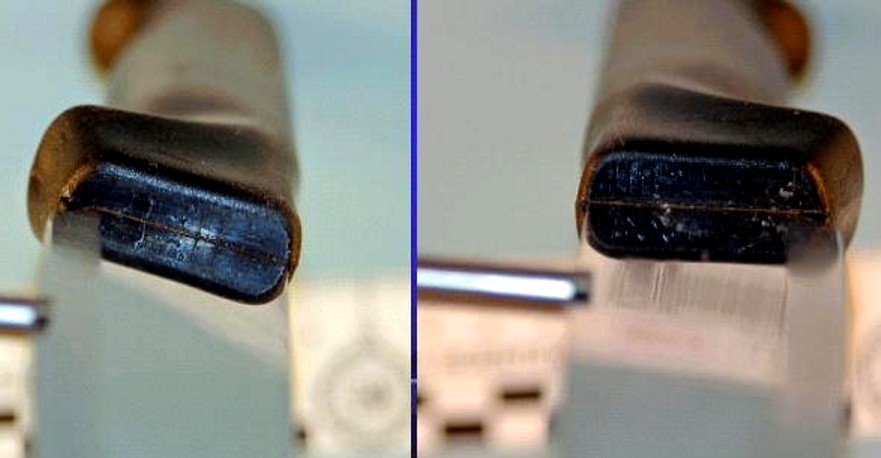
Here is an image showing the I trace in the location described in the post with credit to Iodine of PMF and the Case Wiki
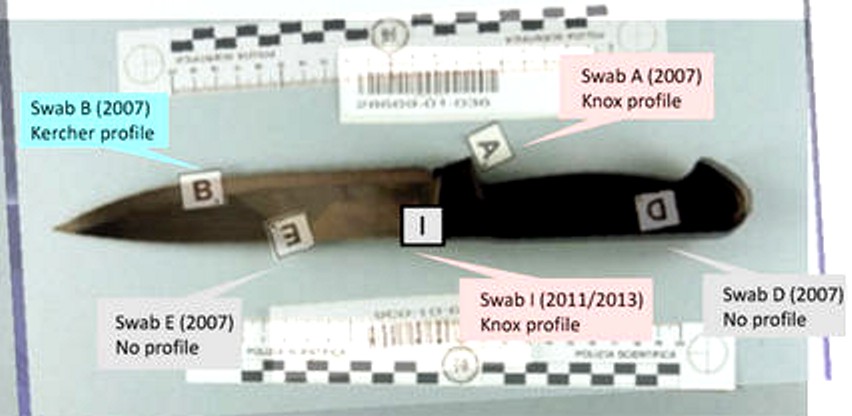
Tuesday, October 22, 2013
The Meredith Case Wiki: A Highly Objective Summation Of The Case From Original Docs And Transcripts
Posted by James Raper
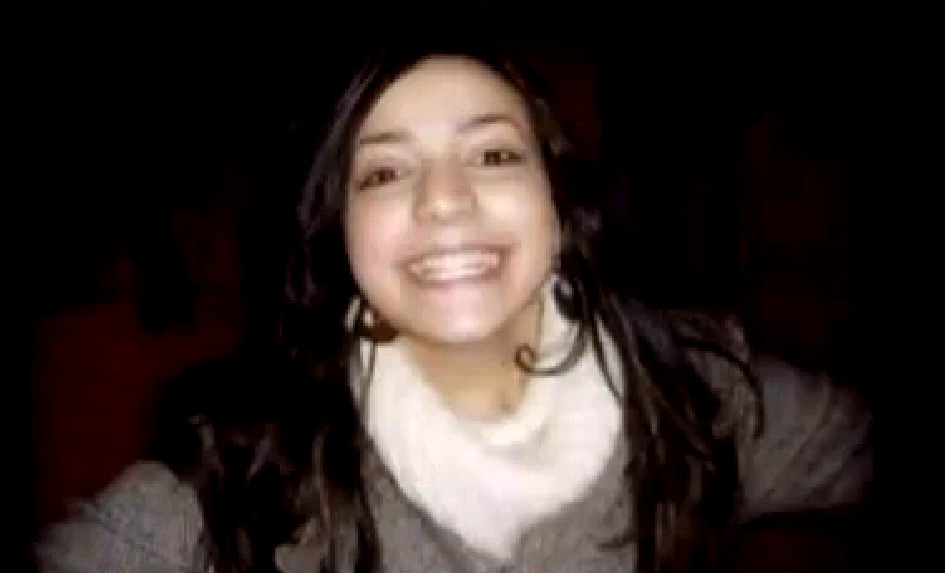
Some of our readers may not have noticed the new link to The Meredith Case Wiki to be found in the left hand column of this front page. I had not noticed it myself until recently.
This is an important link to a new website that is now a vital additional resource for those interested in understanding this case.
The website - The Murder of Meredith Kercher - is run by Edward McCall, with the assistance of other contributors, and TJMK is pleased to acknowledge and promote its distinctive and concise approach to presenting the facts of the case.
The site is modelled on the format of a page from the Wikipedia free encyclopedia. As with a Wiki page it is easily navigable. The data presented under the various headings is the consequence of much research but it still remains a work in progress. Wherever possible the material used is referenced in footnotes.
It starts on the Main page with a Mission Statement and an Introduction to the case. It then considers the evidence and has a good section entitled Myths Debunked.
The reader can easily access significant court documents: the Massei Report, the Hellmann Report, the Galati Appeal and the Supreme Court of Cassation Motivations Report. There is an accessibly summary of the Matteini and Micheli Reports.
In particular, for the researcher, there is a most welcome section entitled Court Transcripts. Here can be found transcripts of witness testimony from the Massei and Hellmann trials, experts reports, and the various writings and testimony of Amanda Knox, Raffaele Sollecito and Rudy Guede. At least that is to be the hope ultimately as there exist a good number of gaps at present.
Already some of the witness statements have been translated from Italian to English but there are a number of transcripts still to be translated. If there are any translators who would wish to help, please contact us and we shall be pleased to put your name forward.
McCall wishes to acknowledge the massive contribution made by True Justice for Meredith Kercher. TJMK has perforce grown organically and exponentially over the years and has accumulated a breadth and wealth of data, in-depth analysis and informed comment on the case which is unsurpassed on the internet, or indeed anywhere.
It will continue to do so and report developments until the conclusion of all aspects of the case.
Monday, October 14, 2013
Carabineri Labs Might Prove Fourth And Conclusive Scenario For The Mixed DNA Samples In The House
Posted by Peter Quennell
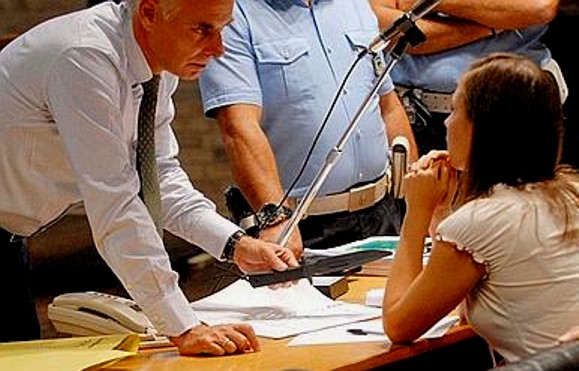
Lab work is believed to have continued today in the absence of the defense observers, and will continue on and off through to October 30th.
The defense observers may not have a further role at the laboratory. Most or all of the analysis leading to firm attributions of the DNA will be done by the Carabinieri team electronically.
It is that final attribution that the defenses are widely rumored to be so terrified of. That Knox’s DNA is there seems a given. The cliffhanger is whether Meredith’s DNA is there also.
Another possible mixed trace. If so it would be the sixth one.
Judge Massei did not arrive at a full scenario for how the five mixed blood traces at the crime scene could have been created. He described what was found by crime scene investigators and moved on.
After the 2009 Massei trial some further analysis was conducted.
With great help from Luciano Garofano’s DNA chapter in Darkness Descending and Barbie Nadeau’s and Andrea Vogt’s excellent reporting, we posted a comprehensive update mid-2011.
The locations of the five mixed traces at the crime scene are as follows.
1. Bathroom near Meredith’s room:
- On the drain of the bidet
- On the Q-tip box located at the ledge of the sink
- On the edge of the sink
Elsewhere in the apartment:
- In a luminol-enhanced bare footprint in the hallway outside Kercher’s room
- In a luminol-enhanced spot found in Filomena Romanelli’s room
Three sources for Knox’s blood have long been suggested: some bleeding from her ear, some bleeding from a possible nosebleed, some bleeding from the open scrape on her neck. .
All three of them could theoretically have been inflicted by Meredith as she struggled with the trio to save her life. None seem to explain why there were repeated MIXED traces.
That has remained a huge puzzle. But now we are looking at a fourth scenario: that Knox cut her hand with the top end of the blade as she stabbed at Meredith’s neck.
That could explain once and for all where Amanda Knox’s blood came from AND why it was mixed with Meredith’s blood. It happened right there.
[Click for larger image. Handle as from the blade direction. Sample is apparently from gap on sharp side.]


